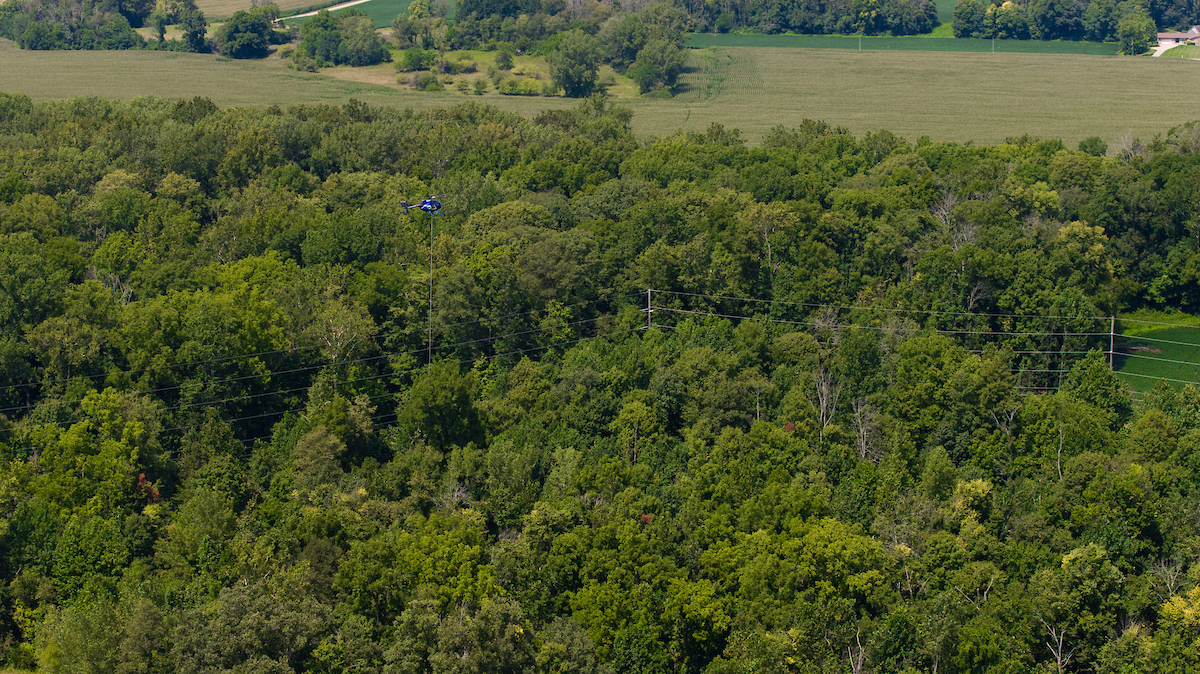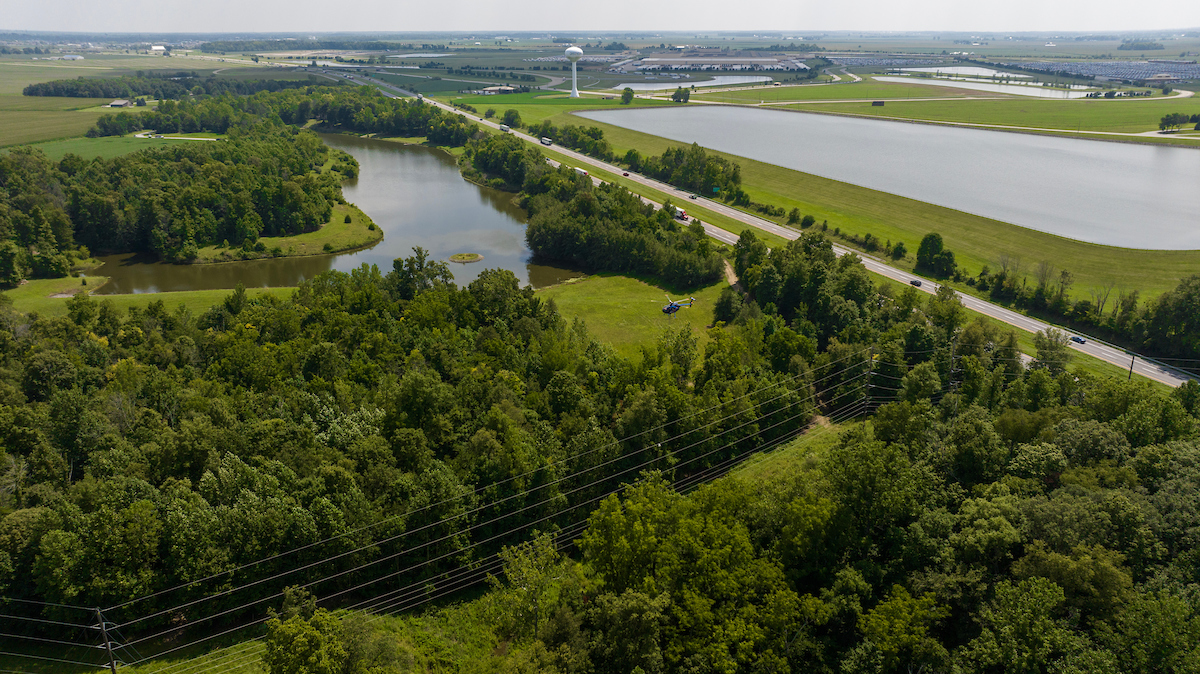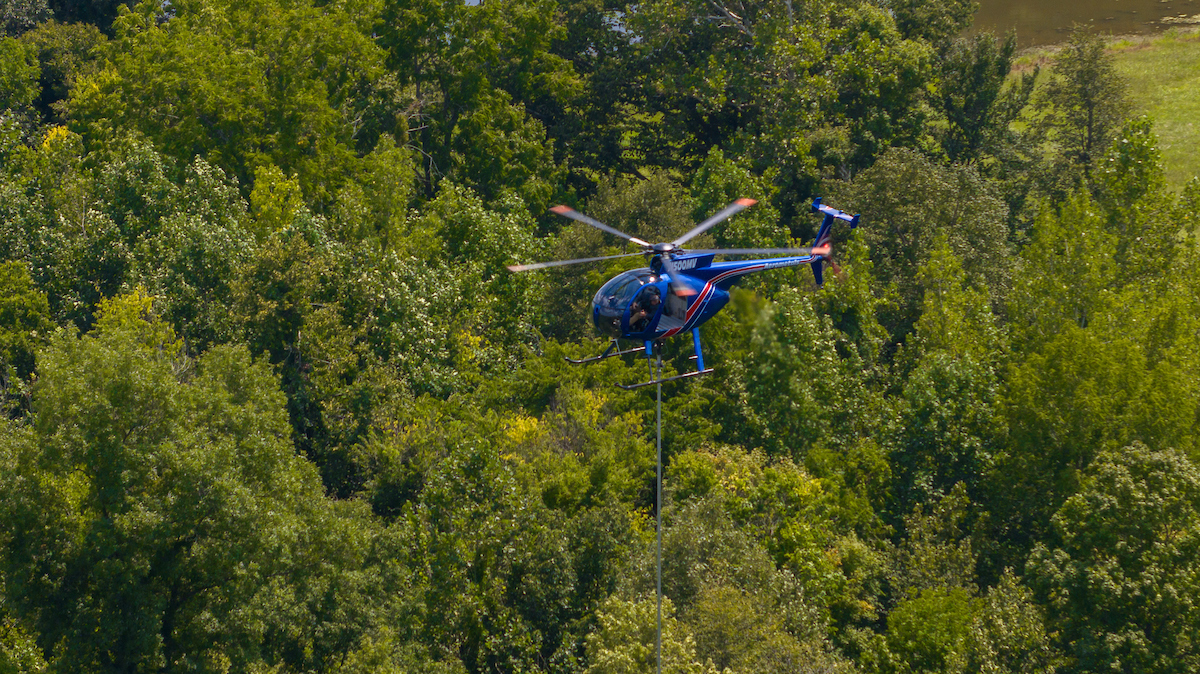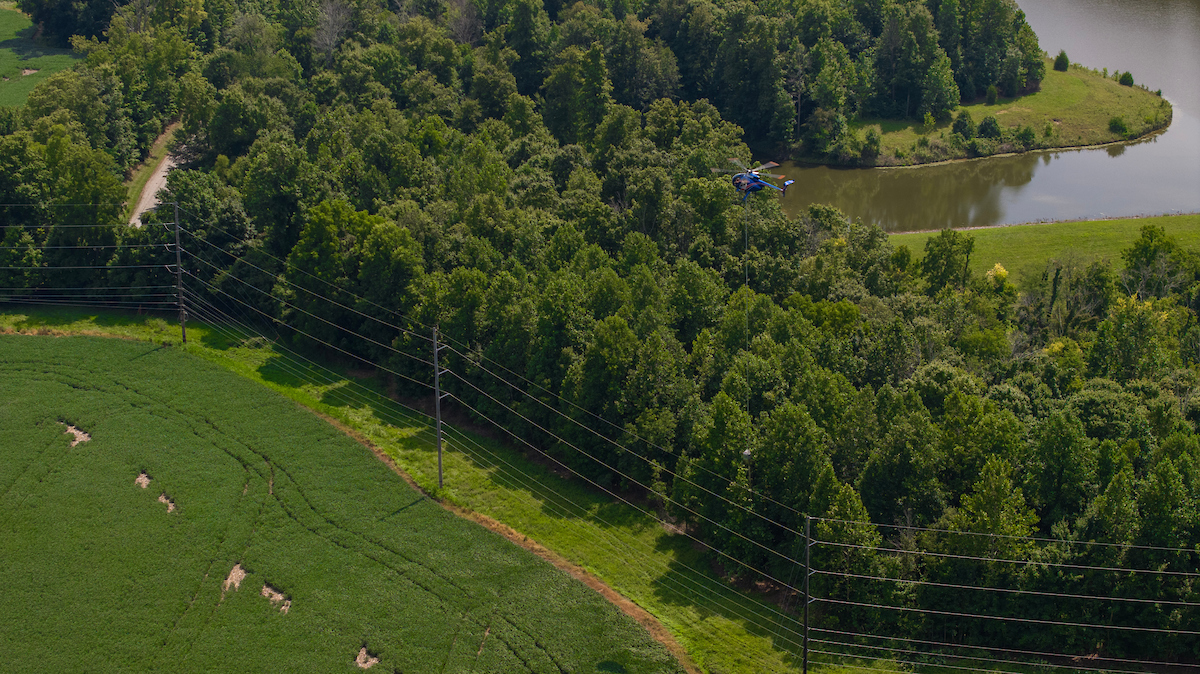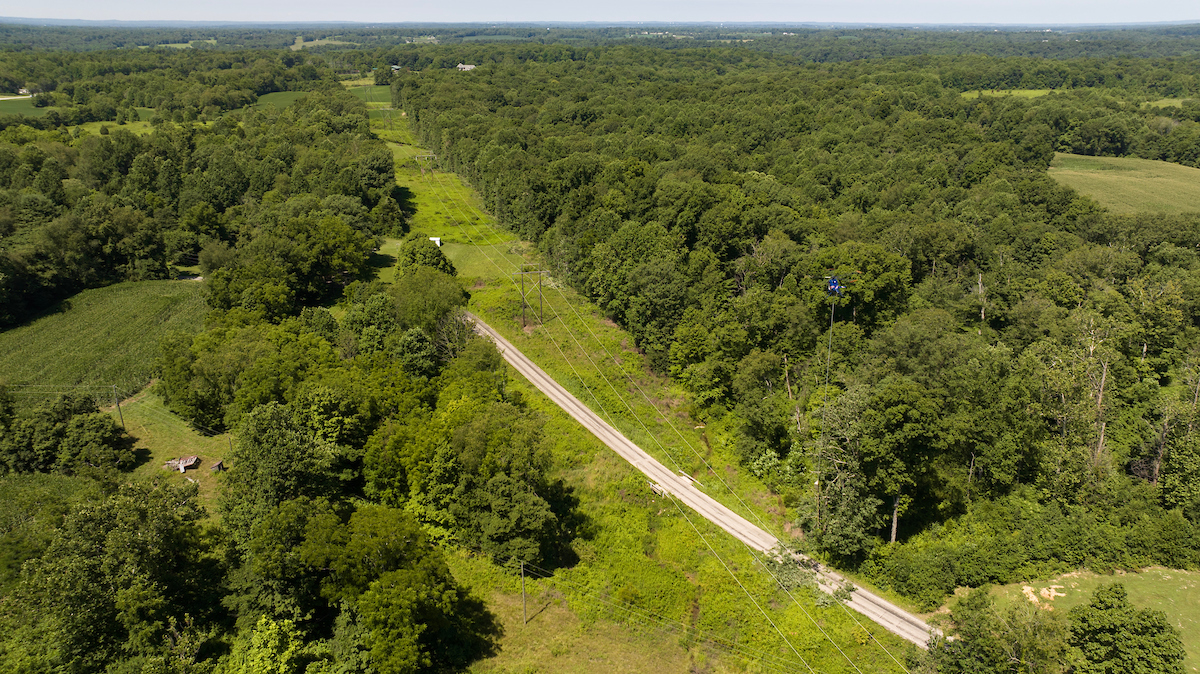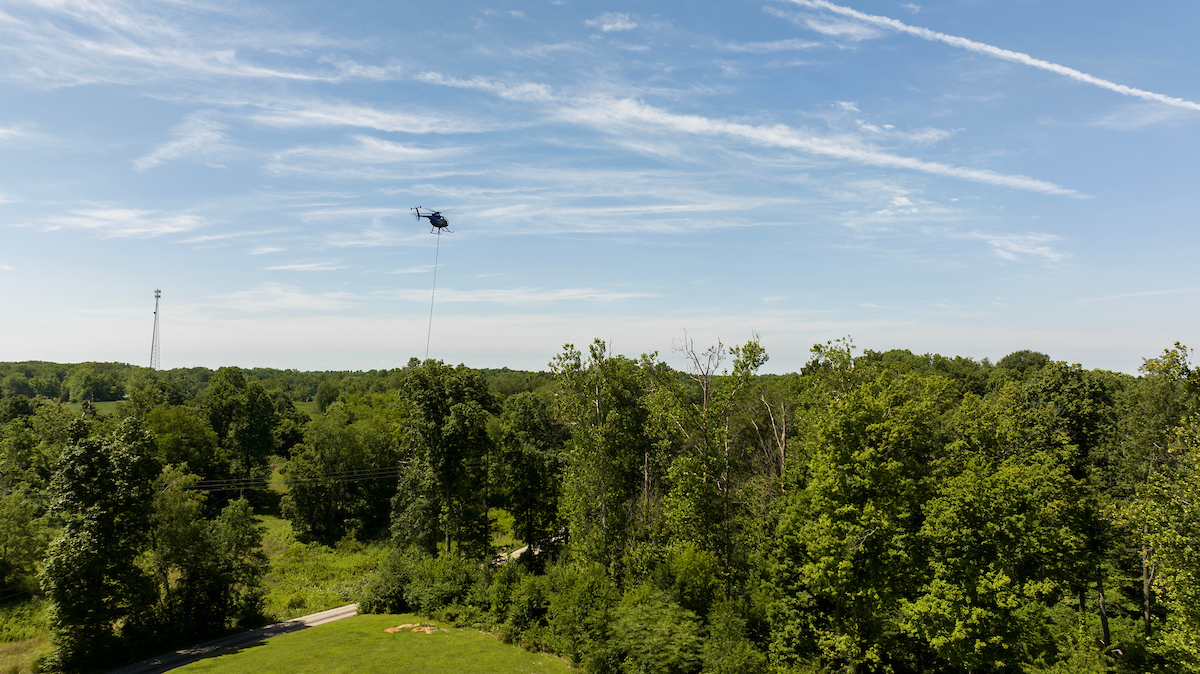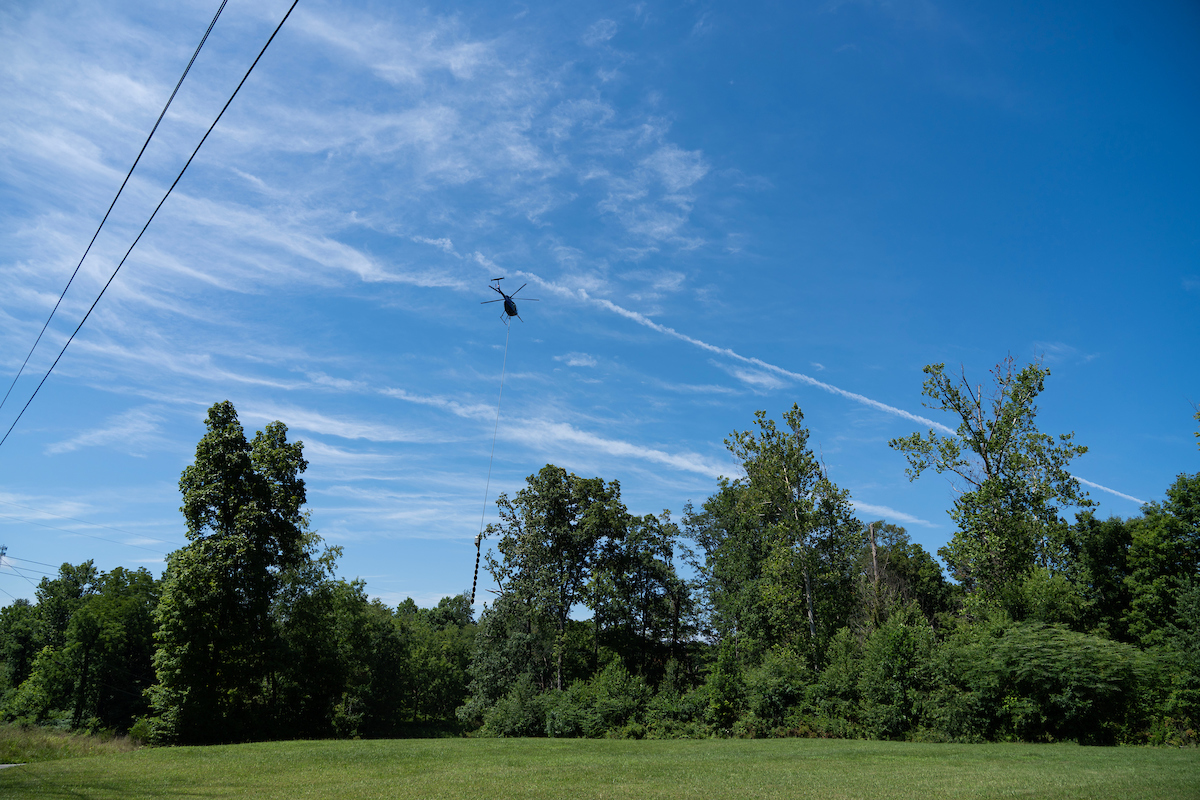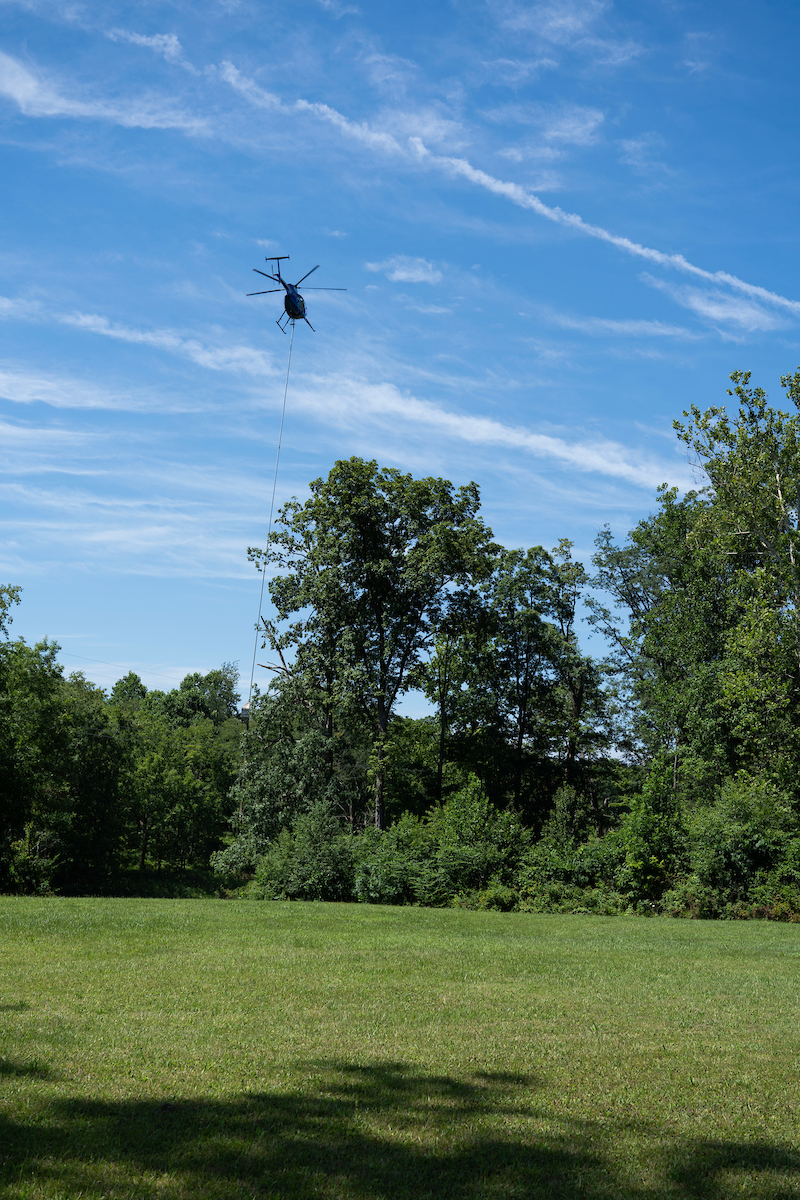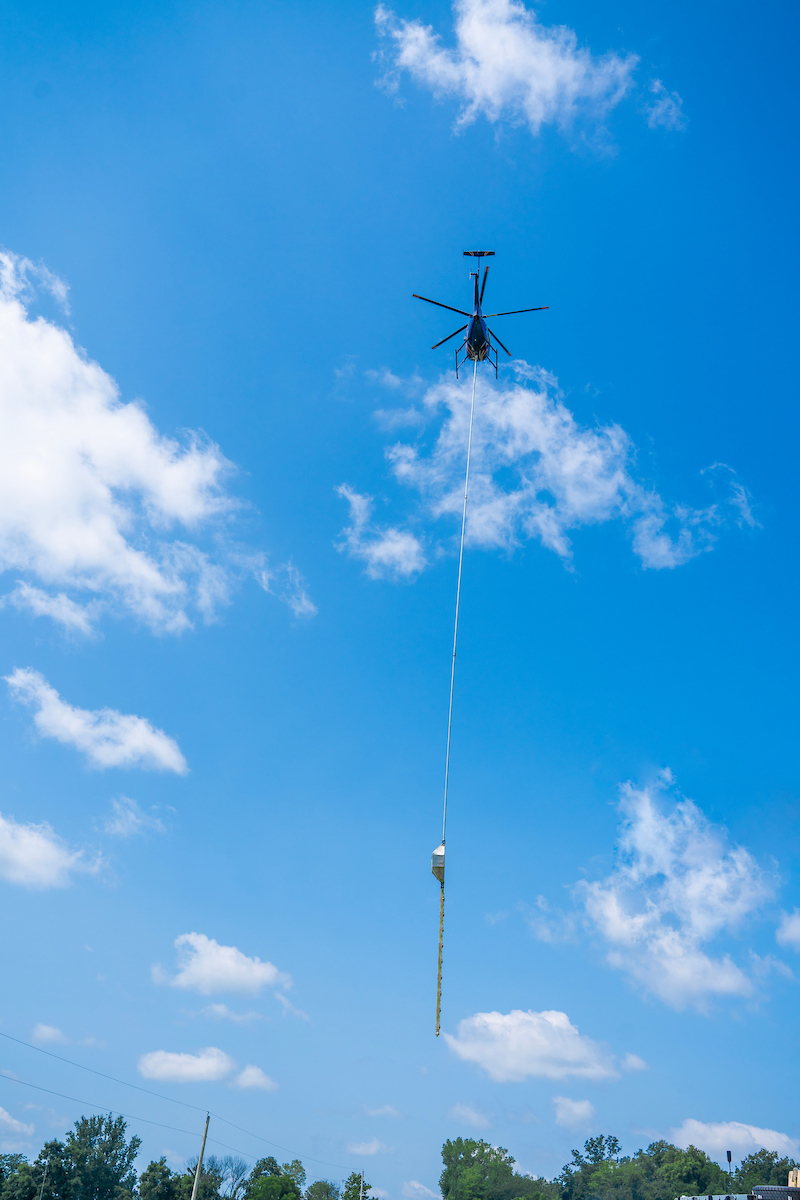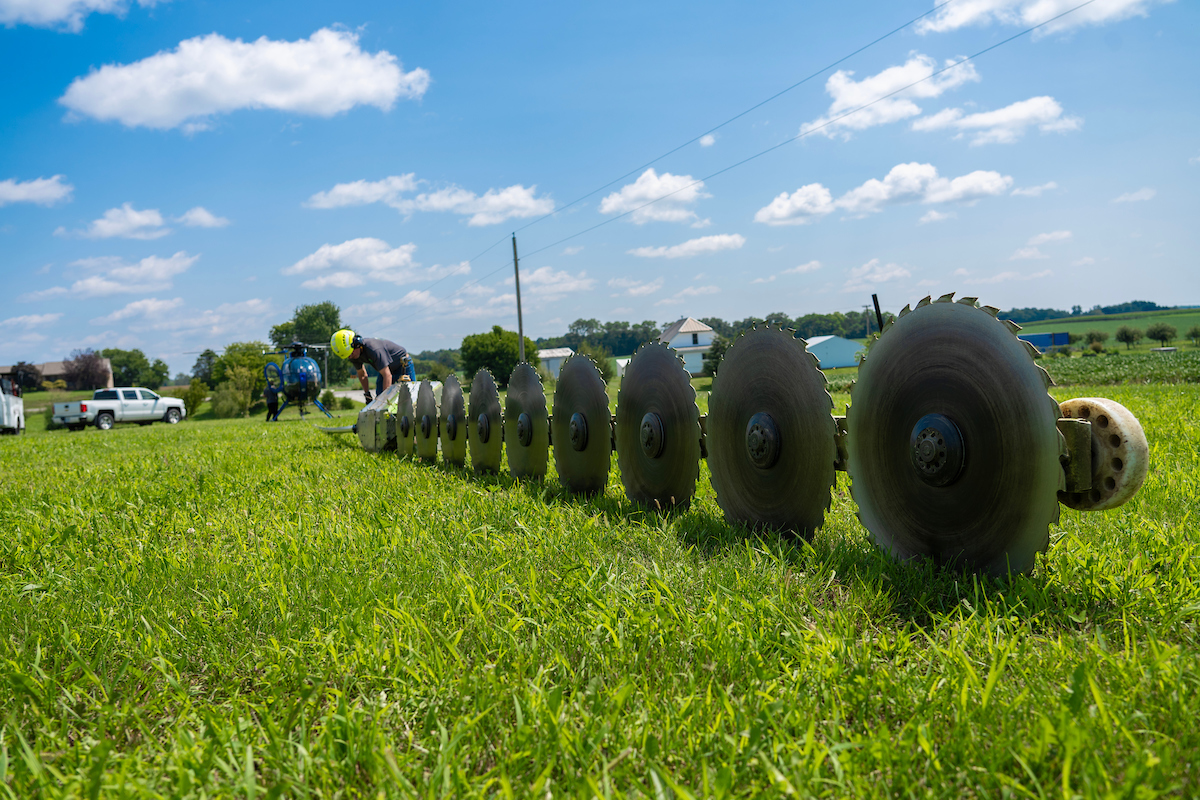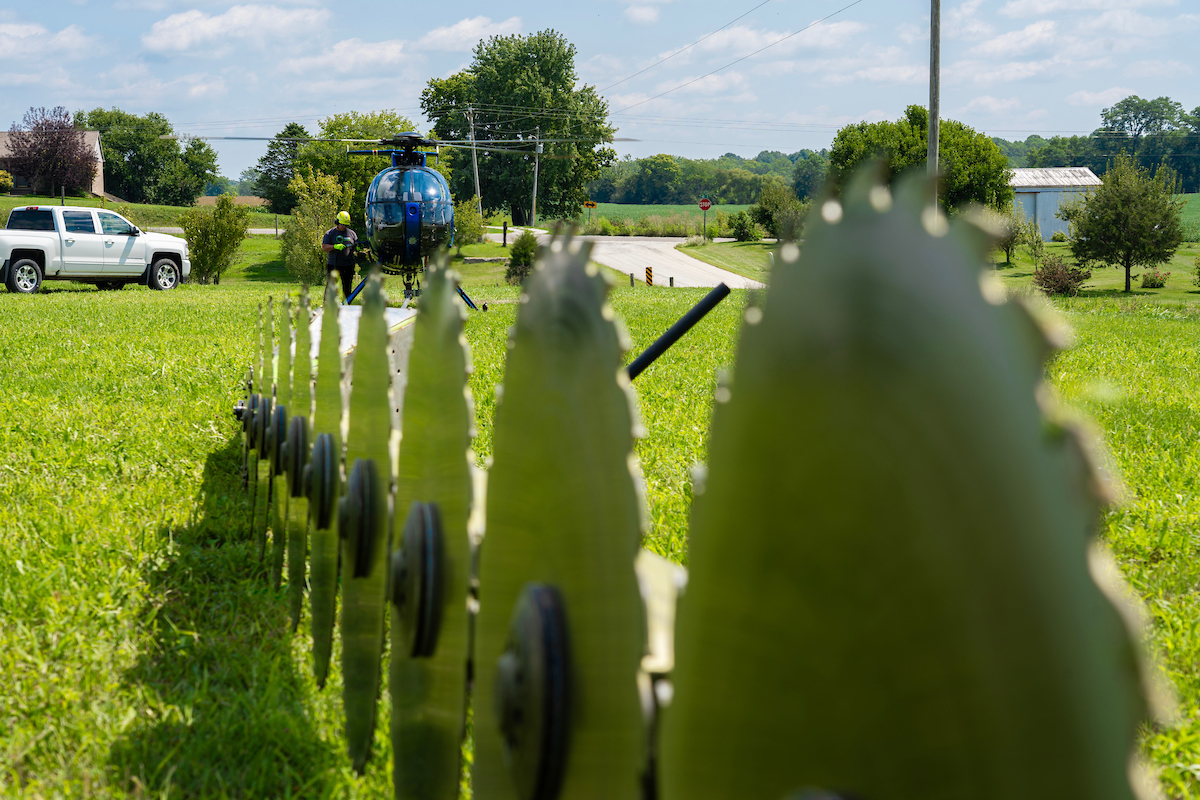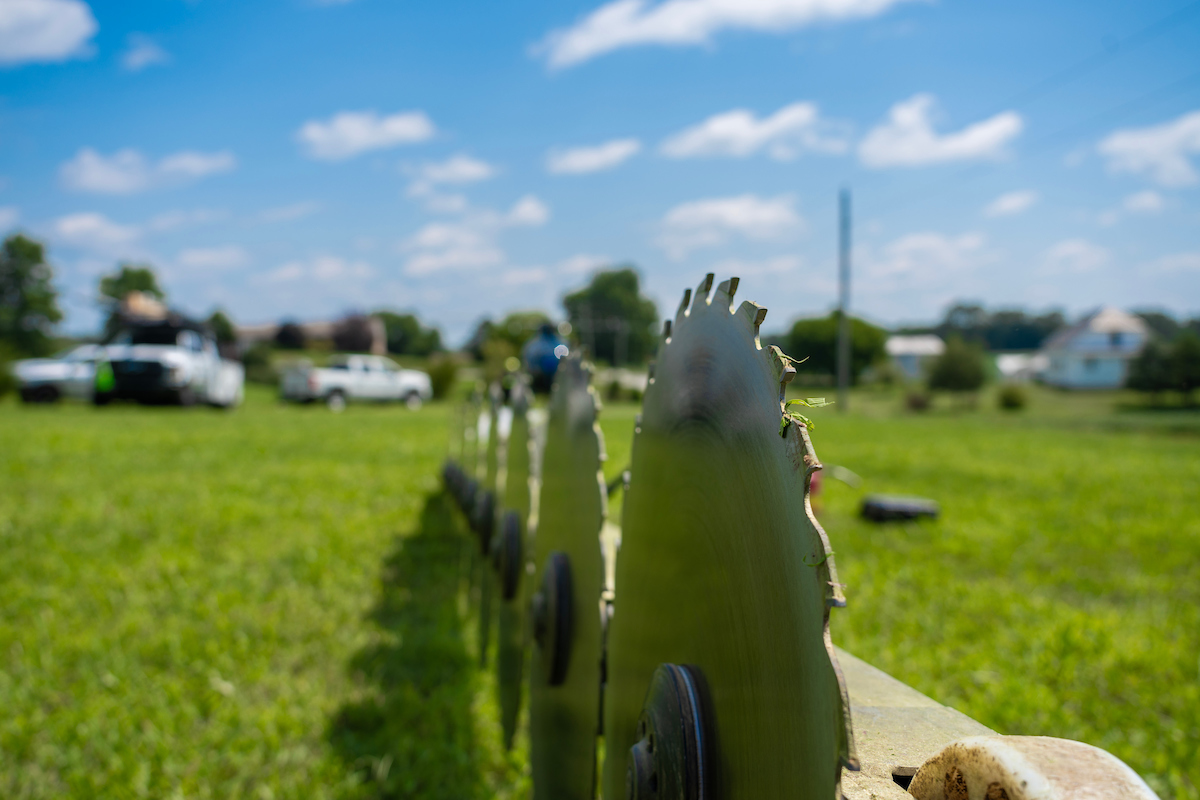Nine 25-inch carbide tip circular saw blades attached to multiple 20-foot aluminum poles and powered by a 50-horsepower snowmobile motor that can be turned on and off remotely – attached to the bottom of a helicopter?
It sounds like the kind of crazy, homemade contraption that would make even Tim the Toolman jealous.
However, the aerial saw is one of Hoosier Energy’s most cost-efficient and time-efficient tools in providing affordable and reliable power to its members and their member-consumers.
“We complete the same amount of work in a window of four to six weeks that would involve multiple tree-climbing crews, bucket truck crews and potentially other mechanical ground-based equipment over several months,” Hoosier Energy Vegetation Management Coordinator Jared Murphy said. “On top of that, it improves safety as exposure to hazardous work conditions is reduced.”
The aerial saw program began in 2018 on a trial basis, and when a pilot program in 2019 produced satisfying results, it became a fixture on the yearly calendar.
“We first brought in a company to try out the aerial saw just to see what they could do – any efficiencies we could gain and the benefits of being able to trim from the ground to the sky,” Murphy said. “We really liked what we saw in the pilot program for a couple of weeks in February of 2019 and have been doing aerial saw trimming ever since.”
The trimming is done along a stretch of 150-200 miles of line each year, a relatively small amount compared to bigger utilities such as Ameren and Duke Energy which typically trim closer to 1,000 miles per year.
But Hoosier Energy is on a four-year cycle to keep each region of transmission lines under control while Murphy takes two flights a year over the lines to identify potential danger trees or other hazards that need more immediate attention.
PREPARE FOR TAKEOFF
Before a blade ever touched a tree in July, there was plenty of work being done to make it possible.
Six weeks in advance of the aerial saw arriving, foresters went out and used high-visibility flagging tape to mark the easement boundary to ensure limbs are not being trimmed further back than Hoosier Energy has rights.
Most easements are 100 feet wide – 50 feet from the center of the transmission line on each side while higher voltage lines such as 161 kV and 345 kV have 150-foot easements, 75 feet from the center.
Regulations also prevent the aerial saw from working within 160 feet of homes or occupied dwellings and businesses.
The foresters are also marking potential hazards such as fences, tree stands and hunting blinds – anything that could cause damage to the property or the helicopter.
“We definitely want to be good neighbors with our members and landowners to ensure we have a safe operation and don’t have unnecessary damage,” Murphy said.
Once those items are flagged in the field, they are also marked on a spreadsheet and a map is created for the pilot, the ground crew and the cleanup crew so they know where all the hazards are located and if there is any type of specific cleanup to be done.
The cleanup preparation on the ground is every bit as important as what will take place hundreds of feet in the air.
“A big part of the preplanning and right-of-way flagging is the foresters marking down what equipment will be needed to clean up the vegetation and limbs trimmed by the aerial saw,” Murphy said. “We can either grind the limbs into mulch or we can pick them up with a grapple to pile them for the landowner, or we can windrow them, which is a good environmental practice moving all the limbs to the edge of the easement and creating habitats for small mammals, birds, etc.”
Environmental considerations of all kinds are also critical, especially in areas close to people or animals.
“For example, if you trim a cherry tree, usually within the first 12 hours the leaves will start to wilt, which can be toxic to livestock and cattle in particular,” Murphy said, “so we need to know where those areas are so we can get a cleanup crew in there immediately after the helicopter trims branches to prevent any issues.”
The other people that need to know what’s going on are the property owners. A postcard notification is typically sent out just over six weeks before the aerial saw trimming begins, which coincides with the foresters’ work preplanning and flagging.
“We want landowners to know what’s going on before those folks show up to tie ribbons on their trees, so no one’s caught off guard,” Murphy said. “That postcard has my phone number and email address, so if landowners have a question, they can give me a call. And they sure do!”
The most common question is: When will the saw be on my property?
“People want to come out and see it,” Murphy said. “They tell me, ‘I want to watch this thing,’ or ‘My kids are really excited about it. We want to see what this is all about.’”
The next most asked question is: What are you going to do with the limbs you leave behind?
“It’s good to get out in front of this stuff,” Murphy said. “With this kind of tool, we don’t want to surprise anybody. Having those conversations up front, letting people know what to expect, what the finished product is going to look like, the debris we’re going to leave behind or options of what we can do to take care of it for them – it’s good to have those discussions beforehand.”
THE AERIAL ASSAULT
Once the prep work is complete, there is nothing left to do but send a helicopter and its spinning blades – both above and below – skyward. The first aerial saw company out of North Carolina has been flying for nearly 40 years as the industry has slowly expanded with multiple companies available for the type of contract work Hoosier Energy is doing.
The MD 500 series helicopter was first produced in 1967 and has been utilized extensively for aerial observation, law enforcement and utility work.
The pilot usually has his own ground crew of one or two people to help refuel the helicopter, refuel the saw, and to check the saw blades and motor.
These refueling breaks take place approximately every 45 minutes, sometimes a little less or a little more depending on the conditions, the trimming and the distance to the launch site, which may move just once or perhaps multiple times a day as progress down the transmission lines is made.
The break lasts 10-15 minutes, except for lunch, which might turn into a 20-minute break, but the goal is to maximize every hour of the day with the helicopter left running so work can resume as quickly as possible.
The daily progress can vary from five miles to 10 miles depending on weather conditions, the thickness of the vegetation being trimmed and any possible equipment delays, such as the time the saw embedded itself in a tree or the day the motor overheated and caught fire.
Such incidents are the exception rather than the rule, and each bit of progress is charted on another spreadsheet.
The cleanup crew on the ground is also in radio communication with the pilot, noting potential issues while staying at least 300 feet clear of the helicopter and the saw.
“The spotters are the same people that went and marked all the hazards prior to the aerial saw starting work,” Murphy said. “Those guys are maintaining communication to make sure the pilot doesn’t cut any fences or hunting blinds or deer stands. Sometimes they’ll spot old cars or junk in the right-of-way, and we don’t want to hit any of that either. The saw is expensive, and the helicopter is too.”
As a matter of fact, the average price for a pre-owned MD 500 helicopter is $1.25 million, while the aerial saw assembly with motor and blades runs nearly $70,000.
Protecting those investments is in the best interest of all involved.
But no one has control over the weather.
“The helicopter can fly with a little bit of rain but obviously not lightning,” Murphy said. “If you’ve got a storm rolling in, they must get on the ground quickly. If it’s just light rain and there’s still visibility and the cloud ceiling isn’t too low, they can still fly, but any amount of rain hurts visibility.”
Low visibility is not only dangerous for the helicopter but also for the pilot’s ability to see the markings below.
Once the trimming is complete, the cleanup crew springs into action.
“We have from two to five crews going at the same time to keep up with the helicopter,” Murphy said. “And we have a really good system our right of way foreman, Brandon Mescall, came up with via a text message thread. Whatever crew is available will like (thumbs up) a message detailing the location, type of cleanup and equipment needed to claim the project, then respond with an exclamation mark (emphasize) the text message to let everyone know it’s done. I thought that was innovative.”
STICKING THE LANDING
In the end, it’s hard to argue with the results of the aerial saw.
“This saw sets a baseline for everything, and the right of way looks like a manicured hedge or something,” Murphy said. “You can walk up to a right of way a mile long, and it’s almost perfect, but I can’t even draw a straight line with my lawnmower.”
While the pilot gets a good deal of credit for that accuracy, the task is a collective effort from those on the ground and in the sky.
“It all goes back to the importance of building a good team around this thing,” Murphy said. “I think the biggest thing we’ve learned over the years is the importance of our ground support team and a good contractor to provide cleanup behind the aerial saw. It’s all really fast-paced.”
Three years ago, Hoosier Energy got a recommendation via member cooperative Southeastern Indiana REMC, and ever since Matt Comer Excavating has served as the contractor for aerial saw cleanup.
Around the same time, Mescall was hired as a contracted work planner, who earlier this year was hired as Right of Way Foreman, while Lance Ellett was hired as Equipment Operator. Both have been invaluable additions to what is now a well-oiled machine.
“The aerial saw is such a cost-effective, time-saving tool,” Murphy said. “If we didn’t use the aerial saw, it would take multiple crews multiple months to do the same thing we do in a few weeks, so the exposure to danger is much lower as is the risk of someone having an accident. The value of the aerial saw goes well beyond the monetary benefits.”
Those benefits are no small thing though.
When the program first started, Hoosier Energy was able to save about 10% on the total cost by using aerial trimming over traditional methods.
With the refinement of methods and contractors, a top-tier team has seen Hoosier Energy save an average of 40% on trimming costs over the past three years.
Combine it all together, and it’s a win-win situation.
“Most of our transmission lines are of a rural nature,” Murphy said. “They’re not running along the road for the most part, so the aerial saw is a great tool for us at Hoosier Energy. It might not be great for other utilities with a lot of lines running along the road or near homes and businesses, but for us it really makes sense.”
